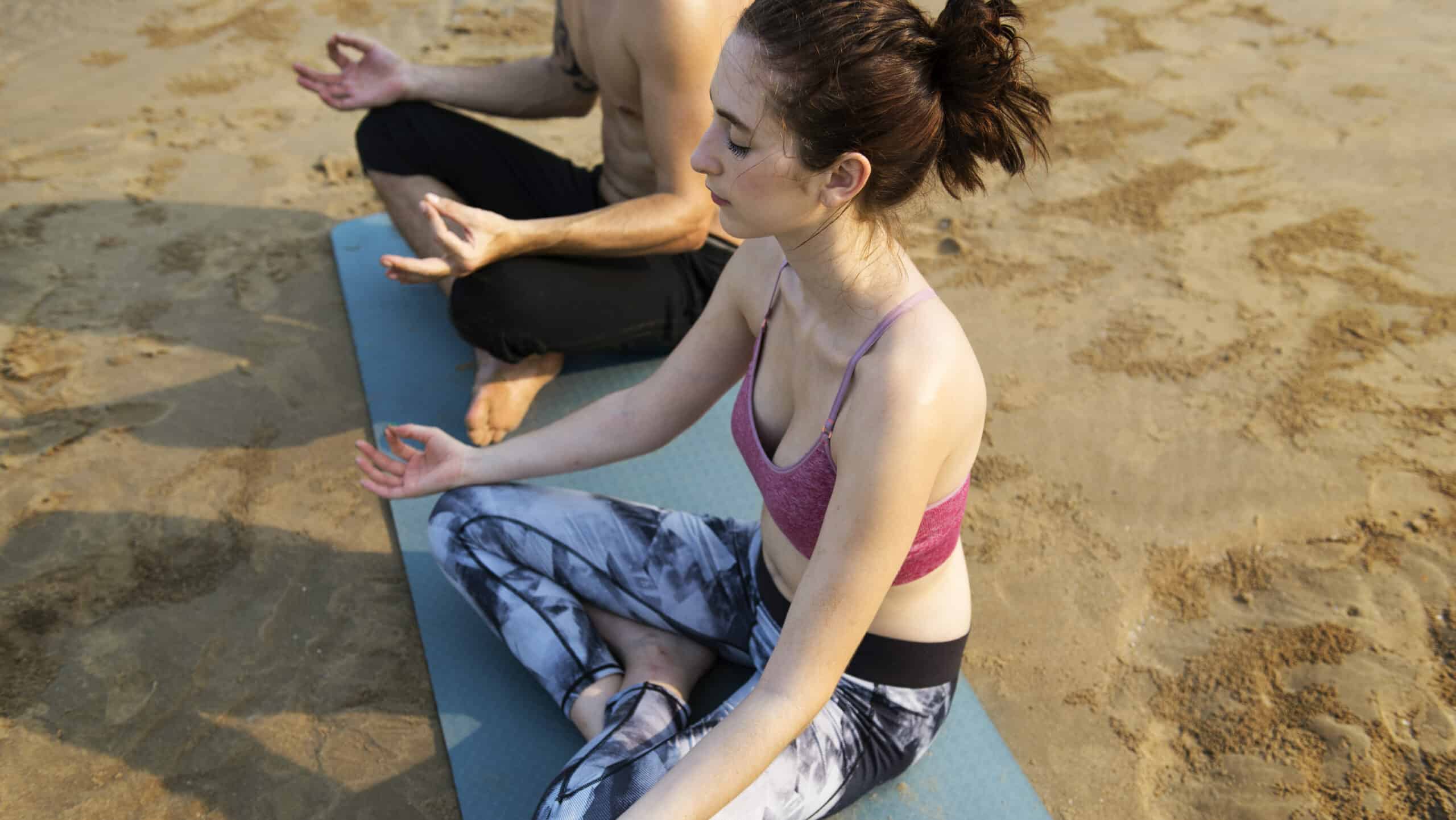Exploring the benefits of holotropic breathwork can be a transformative journey for spiritual seekers and those looking to improve their overall well-being. Recent times have seen a surge in the popularity of this powerful breathing method, with numerous people noting substantial enhancements to their psychological and emotional health. In this blog post, we will delve into the origins of holotropic breathwork, its underlying principles, and how it can positively impact your life.
Before engaging in holotropic breathwork, it is important to be aware of safety considerations and contraindications for optimal benefit. Additionally, finding trained facilitators who can provide proper guidance is essential for maximizing the potential benefits of holotropic breathwork sessions.
Lastly, setting intentions before participating in a session plays an important role in shaping your experience. We’ll explore various examples of intentions to consider as you embark on this deeply transformative journey through holotropic breathwork.
Holotropic Breathwork Basics

Holotropic breathwork is a therapeutic breathing practice that involves rapid, deep breathing for extended periods of time. Through rapid, deep breathing for extended periods of time, holotropic breathwork seeks to induce an altered state of consciousness and foster psychological and spiritual development by raising self-awareness and enhancing one’s perspective on life.
Origins and principles of holotropic breathwork
The term holotropic comes from the Greek words “holos,” meaning whole, and “trepein,” meaning to turn or move towards. Stanislav and Christina Grof developed holotropic breathwork in the 1970s, combining ancient shamanic practices with modern psychology to help individuals access non-ordinary states of consciousness. The idea behind holotropic breathwork is that accelerated breathing can help individuals access non-ordinary states of consciousness where they can gain insights into their emotional well-being, relationships, personal history, or even past lives.
The process involved in a typical session
A typical holotropic breathwork session lasts between two to three hours. Participants usually lie down on mats with their eyes closed while engaging in diaphragmatic breathing exercises under the guidance of trained facilitators who monitor their physical safety throughout the experience. Sessions are often accompanied by evocative music which helps set the mood for introspection.
- Preparation: Before beginning a session, participants should wear comfortable clothing and remove any jewelry or accessories that might interfere with deep breathing.
- Breathing techniques: Holotropic breathworkers use various types of rapid inhalation followed by slower exhalation patterns.
- Integration: After the breathing exercises, participants are encouraged to share their experiences and insights with others in a group setting. This helps them process any emotions or realizations that may have arisen during the session.
The intensity of holotropic breathwork’s impact can vary greatly from person to person, but many individuals report experiencing emotional catharsis, spiritual awakenings, and even physical healing as a result of this practice. It is essential to approach these sessions with a mindset of openness and willingness to accept any unforeseen revelations.
Holotropic breathwork is a powerful tool for personal transformation, and its potential benefits can be further explored in the next heading. Exploring the fundamentals of holotropic breathwork can reveal how it may help with mental health, emotional stability, and interpersonal connections.
Benefits of Holotropic Breathwork

Practitioners claim numerous benefits from engaging in holotropic breathwork, such as overcoming negative thoughts or fears (including the fear of death), managing trauma, enhancing creativity, fostering personal transformation, and finding new purpose or direction in life. A 2015 study supports these claims by demonstrating increased self-awareness following sessions.
Mental Health Improvements Through Holotropic Breathwork
Breathing exercises that induce an altered state of consciousness can help alleviate mental health issues such as anxiety and depression. By entering an altered state of consciousness through deep breathing exercises, individuals can access repressed emotions and memories that may be contributing to their psychological distress. This emotional catharsis can lead to improved mental well-being over time. By practicing diaphragmatic breathing regularly, individuals can reduce their stress levels and cortisol production.
Enhanced Emotional Well-Being
The intense experience during holotropic breathwork sessions often leads participants to confront unresolved emotions and past traumas head-on. This process allows for emotional release and healing which contributes significantly towards enhanced emotional well-being. As a result, many people report feeling lighter emotionally after participating in holotropic breathwork practices.
Strengthened Connections with Others
- Social bonding: Participating in group holotropic breathwork sessions fosters a sense of community among attendees as they share profound experiences together.
- Elevated empathy: The heightened self-awareness gained through this practice enables individuals to better understand others’ feelings and perspectives leading them towards more empathetic relationships.
- Improved communication: As holotropic breathwork helps individuals become more in tune with their emotions, they can communicate more effectively and authentically with others.
In addition to these benefits, many people also report experiencing a deeper connection to the natural world and an increased sense of spirituality after engaging in holotropic breathing practices. This expanded awareness contributes to overall well-being and personal growth.
Holotropic breathwork can bring a range of advantages, from better mental health to more emotional stability. It is important to be aware of safety precautions and contraindications before engaging in this practice so that it can be done safely.
Safety Precautions & Contraindications

Although many people find holotropic breathwork beneficial, it can evoke intense emotions which may not be suitable for everyone. It is important to consider your personal health and well-being before participating in this practice. In this section, we will discuss some medical conditions that are incompatible with holotropic breathwork and the importance of consulting with healthcare professionals before starting.
Medical Conditions Incompatible With This Practice
Individuals with certain medical conditions should exercise caution or avoid holotropic breathwork altogether. Some of these conditions include:
- Panic attacks, psychosis, or disturbances: Holotropic breathing can trigger intense emotional responses that might exacerbate existing mental health issues. If you have had panic attacks or other psychological issues in the past, speak to your doctor before engaging in holotropic breathwork.
- Severe mental illness: People diagnosed with severe mental illnesses such as schizophrenia or bipolar disorder should avoid holotropic breathwork due to its potential impact on their condition.
- Epilepsy or seizure disorders: The altered state induced by rapid breathing could potentially increase the risk of seizures for those who suffer from epilepsy or similar neurological conditions.
- Aneurysms and family history thereof: If you have a personal history of aneurysms or if they run in your family, it’s crucial to speak with a healthcare professional prior to attempting any form of intensive breathing exercises like holotropic breathwork.
Discussing Concerns With Your Doctor Before Starting
If you’re considering trying out holotropic breathwork but are unsure whether it’s safe for you given your current physical and mental health status, discussing your concerns with a healthcare professional is highly recommended. A healthcare professional can evaluate the possible dangers and advantages of holotropic breathwork, considering your medical background and any existing issues.
It’s also essential to inform your holotropic breathwork facilitator about any health concerns or medications you’re currently taking. This will enable them to provide proper guidance and ensure that they are aware of any potential contraindications during the session.
In addition to consulting with healthcare professionals, it’s important to educate yourself on the possible risks associated with holotropic breathwork in order to make an informed decision about whether this practice is right for you.
Realizing the possible dangers and prohibitions related to Holotropic Breathwork is crucial prior to partaking in this technique. Consequently, one should seek out a certified practitioner to guarantee the correct implementation of Holotropic Breathwork.
Finding Trained Facilitators & Proper Guidance

When considering holotropic breathwork, it is crucial to ensure your safety and maximize the potential benefits by seeking out a trained facilitator who is licensed and has received proper training. These professionals are well-versed in guiding participants through holotropic breathwork sessions, providing support during the emotional journey, and ensuring that the environment remains safe for everyone involved.
Credentials Required for Facilitators
Qualified holotropic breathwork facilitators undergo rigorous training programs that cover various aspects of this practice, including its history, principles, techniques, as well as ethical considerations. Some reputable organizations offering such training include the Grof Transpersonal Training (GTT) program or the Breath Mastery School. It’s essential to verify that your chosen facilitator has completed an accredited program before participating in a session.
How to Locate Qualified Practitioners
- Referrals: Ask friends or family members who have experienced holotropic breathwork if they can recommend a qualified practitioner. Personal recommendations can be invaluable when searching for a trusted professional.
- Holistic centers: Many holistic health centers offer different types of alternative therapies like yoga classes or meditation workshops alongside their more traditional offerings such as acupuncture treatments; these places may also provide referrals to local practitioners.
- Social media groups: Join online communities dedicated to holotropic breathwork and ask for recommendations. Members of these groups often share their experiences with different facilitators, providing valuable insights into finding the right practitioner.
- Online directories: Utilize online resources such as the Holotropic Breathwork Facilitator Directory, which lists certified practitioners worldwide. These directories can help you find a qualified professional in your area.
Taking the time to research and select a trained facilitator is an essential step in ensuring that your holotropic breathwork experience is both safe and transformative. By prioritizing proper guidance, you will be better equipped to navigate this powerful therapeutic practice and reap its many potential benefits on your journey towards improved mental health, emotional catharsis, and spiritual growth.
It is essential to research and find a trained facilitator for Holotropic Breathwork sessions, as this will ensure that you are receiving the proper guidance. Setting an intention before participating in a session can help guide your experience and maximize its potential benefits.
Your Intentions Before Participating In A Session

Setting intentions prior to beginning any type of holistic therapy can help guide the experience and allow for greater personal growth. By establishing a clear purpose or goal, you can better navigate the emotions and insights that arise during your holotropic breathwork session. In this section, we will discuss the importance of intention setting and provide examples of intentions to consider.
The Importance Of Intention Setting
Intention setting is an essential aspect of engaging in holotropic breathwork sessions because it helps create a focused mindset. This focus allows participants to be more receptive to the potential benefits offered by these breathing practices. Additionally, having a specific intention provides direction for both the participant and facilitator throughout the session.
A well-defined intention also serves as an anchor point when navigating through intense emotional experiences that may surface during holotropic breathing exercises. It reminds you why you chose to participate in this practice, helping maintain motivation even when faced with challenging emotions or thoughts.
Examples Of Intentions To Consider
- Self-discovery: Engaging in holotropic breathwork with the aim of uncovering hidden aspects of yourself or gaining deeper self-awareness can lead to significant personal growth.
- Healing past traumas: Many people turn towards alternative therapies like holotropic breathing techniques as a means for addressing unresolved trauma from their pasts; having this intention could facilitate the emotional catharsis necessary for healing such wounds within oneself over time.
- Spiritual exploration: If spirituality plays an important role within one’s life then seeking out experiences that allow for further exploration into this realm may prove beneficial – especially when considering how holotropic breathwork has been known to induce altered states of consciousness similar in nature to those achieved during deep meditation practices.
- Enhancing creativity: Some individuals find that participating in these types of sessions helps them tap into their creative potential, allowing new ideas and inspiration to flow more freely as a result.
- Strengthening relationships: By setting an intention focused on improving connections with others, you can use the insights gained from your session to foster deeper understanding and empathy within your personal relationships.
In conclusion, having a clear intention before engaging in holotropic breathwork can significantly enhance the overall experience. It provides direction, focus, and motivation throughout the process while also serving as an anchor point during intense emotional moments. Consider what goals or desires resonate most deeply with you personally before embarking upon this transformative journey.
Frequently Asked Questions Holotropic Breathwork Benefits
What are the benefits of holotropic breathwork?
Holotropic breathwork offers numerous benefits, including mental health improvements, enhanced emotional well-being, and strengthened connections with others. It can also promote self-awareness, spiritual growth, and deep relaxation. This practice is often used as a therapeutic tool for personal transformation.
What happens to your body during holotropic breathwork?
During holotropic breathwork sessions, participants engage in rapid breathing techniques that induce altered states of consciousness. The process may result in physical sensations such as tingling or warmth throughout the body and temporary changes in heart rate or blood pressure. These experiences help facilitate emotional release and psychological healing.
What are the scientifically proven benefits of breathwork?
Scientific research supports various benefits of different types of breathwork practices like stress reduction, improved respiratory function, and increased focus and concentration levels. While there’s limited scientific evidence specifically on holotropic breathwork due to its subjective nature; many practitioners report transformative experiences through this method.
Is it safe to do holotropic breathing alone?
It is not recommended to practice holotropic breathing alone due to potential risks associated with intense emotions or physical reactions that may arise during sessions. It’s essential to work with a trained facilitator who can provide proper guidance and support throughout the experience.
Conclusion
In conclusion, holotropic breathwork is a powerful practice that can have numerous benefits for mental and emotional well-being. Through deep breathing techniques and intentional setting of intentions, individuals may experience improvements in their mental health conditions, emotional catharsis, reduced stress levels, and strengthened connections with others.









